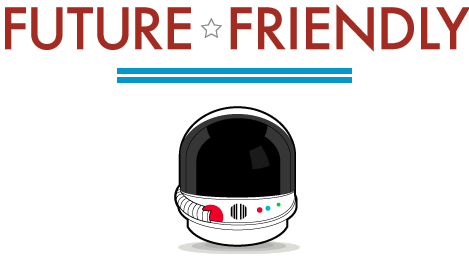

You are part of this thing. When you go future friendly, you help your own work and you offer an example to others, too. Here are some things you can do.
Future-friendliness describes design principles, not specific techniques. Individual techniques will evolve, thrive, and then decline. No single method, technology, or workflow is perfect for all projects. Don't be religious about techniques. Instead, be passionate about future-friendly values.
Use the term "future friendly" when you discuss work that follows these design principles. There is power in a name, and popularizing this phrase is part and parcel of popularizing the ideals behind it. Share the love: use the #ffly hashtag, and emblazon your stuff with the Future Friendly logo (.eps or .ai).
Introduce future-friendly thinking to your peers, employees, and managers. Share this site with them. As you advocate, understand that new ways of thinking often meet resistance. Strive to understand where that resistance comes from. Frame the benefits according to your colleagues' personal goals—for example, business value, empowering users, reaching a larger audience, easing long-term maintenance, whatever matters most to them.
Examine your project's goals, and adopt a process and approach that accomplishes those goals while following future-friendly principles. This website purposely describes only those broad ideals, but the Thinking page links to resources for action and education. The authors of this site frequently write in detail about current future-friendly approaches, and we invite you to get acquainted with our work and share your own with us:
Learn more by following Future Friendly on Twitter at @future_friendly or this list of future-friendly practitioners assembled by Dave Olsen.